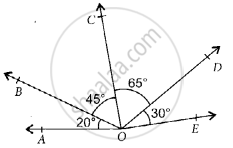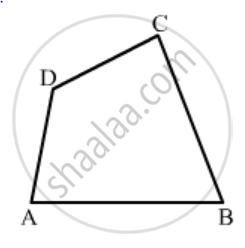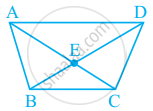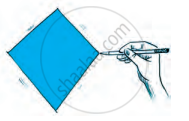Advertisements
Advertisements
प्रश्न
The number of obtuse angles in figure is ______.
विकल्प
2
3
4
5
उत्तर
The number of obtuse angles in figure is 4.
Explanation:
The obtuse angles formed in the given figure are
∠AOD = 20° + 45° + 65° = 130°
∠BOD = 45° + 65° = 110°
∠COE = 65° + 30° = 95°
And ∠BOE = 45° + 65° + 30° = 140°
Thus, there are total 4 obtuse angles formed.
APPEARS IN
संबंधित प्रश्न
Complete of the following, so as to make a true statement:
The sum of the angles of a quiadrilateral is .... right angles.
In Fig. 16.19, ABCD is a quadrilateral.
Name a pair of adjacent angles.

PQRSTU is a regular hexagon. Determine each angle of ΔPQT.
In the given figure, PQRS is an isosceles trapezium. Find x and y.

Given : In quadrilateral ABCD ; ∠C = 64°, ∠D = ∠C – 8° ; ∠A = 5(a+2)° and ∠B = 2(2a+7)°.
Calculate ∠A.
Three angles of a quadrilateral are equal. If the fourth angle is 69°; find the measure of equal angles.
The three angles of a quadrilateral are 71°, 110°, 95°. Find its fourth angle.
In given figure, What is AC – EC?
Can we have two obtuse angles whose sum is a complete angle? Why or why not?
Draw a rough sketch of a quadrilateral PQRS. Draw its diagonals. Name them. Is the meeting point of the diagonals in the interior or exterior of the quadrilateral?

